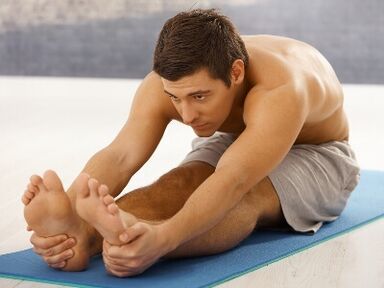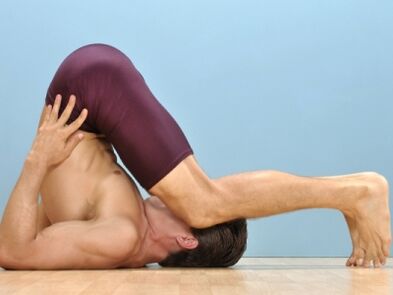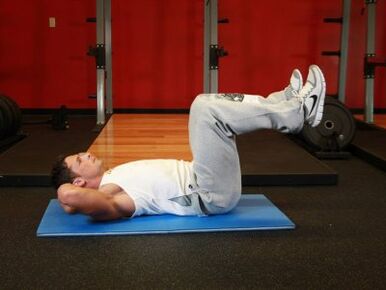
Prostatitis and prostatitis are a fairly common disease in older men.
The main symptom of prostate cancer is difficulty urinating due to urethral compression.
With these diseases, within the framework of complex treatment, together with drugs, folk remedies, such as the use of dead bees to cure prostate tumors, and surgical methods, as well as to prevent blockagecongestion and inflammation, therapeutic exercises are recommended.
Special exercises for prostatitis and prostate tumors should be performed for a long enough time. They are aimed at strengthening the muscles of the pelvis, perineum, lower extremities, increasing the general strength of the body.
In addition, exercises recommended for prostatitis and prostatic hyperplasia are only given to a man after prostate surgery to prevent complications. In this case, they should be done gently and taking into account the patient's state of health.
Physiotherapy for prostate tumors: the main complex of physical exercises

Physical therapy for prostate tumors, as well as massage, improve blood circulation in the pelvic organs.
This can stop the development of the pathological process, reduce the growth rate of benign tumors.
Exercises for prostate cancer include static and dynamic exercises.
Exercises that increase general strength, such as walking, running, or biking, are called dynamic exercises. Also do exercises such as squats, butt walking, rolling on a ball, lifting and leg raising exercises, or elevating the pelvis when lying down.
Static exercises involve standing with stretching of a specific muscle group.
It's useful to note
Strengthening the back and abdominal muscles is essential. For this, exercises are performed in the supine position, on the side, on the stomach, twisting and push-ups. One of the effective exercises is cycling in a supine position, to complicate the exercise - with the pelvis raised.
All sorts of lifts and tilts and rotations of the pelvis are helpful. There are special exercises that target the muscle group of the perineum.
The most famous and effective set of exercises for prostate tumors is the Kegel complex, created by a gynecologist for women and modified for men. Its main exercises are standing and lying, which include training the muscles of the anus and perineum, aimed at preventing blockages in the perineum and small pelvis.
The complex should be carried out in the morning, after hygienic procedures and in the evening. Bedtime exercises with prostate cancer are recommended to be done 2-3 hours before bedtime.
Note
Exercise for prostatic hyperplasia should be carried out taking into account the patient's state of health, it is not recommended to overdo it and force the tempo, the complexity of the exercises must necessarily take into account the patient's age andconsent of the attending physician.
A properly selected set of exercises after prostate surgery can be of great help during the post-operative recovery period. Should exercise regularly.
The exercises themselves do not take much time, but regular use has a beneficial effect on the general condition of the man's body and blood circulation in the pelvic organs, reducing congestion and edema. .
In addition, strengthening the muscles of the abdomen and perineum has a positive effect on the process of urination, and in the future will be an excellent preventive measure against prostate tumors.
Important
Also remember to be moderate in the performance of exercises, they must bring a feeling of refreshment and lightness, but must not be accompanied by a feeling of pain or must be performed with force.
Gymnastics therapy for prostate cancer

Exercises recommended for prostate cancer are performed not only for benign prostatic hyperplasia, it may also be helpful for patients who have undergone surgery for prostate cancer in inflammation. chronic prostate.
Physical therapy combined with drug treatment can help reduce edema and obstruction in the small pelvis, thereby, reducing urethral obstruction and improving urine output. Gymnastics for prostate cancer, or exercise therapy, is performed under the supervision of a specialist, in groups, often in medical settings, and consists of three phases.
At the first stage, a general physical activity is performed, which includes aerobics, running, jumping and warm-up.
In the second stage, special exercises are performed aimed at strengthening the back muscles, abdominal muscles, perineum region, which contribute to emptying of the bladder. Various exercises are also performed to relieve congestion in the pelvic organs.
In the third stage, stretching and relaxation of muscles loaded during training is achieved.
Note
This training process to achieve a stable effect needs to be done regularly and for a long time. Techniques of physical therapy must necessarily be included in the combination of treatment measures, including drug therapy, physical therapy and surgery, if necessary.
Prostate gland enlargement is an age-related disease, and its course is highly dependent on the health and safety of the body.
Adhere to the rules of a healthy lifestyle, regular exercise, proper nutrition and adherence to the diet, avoid bad habits that have a great impact on the quality of life and have a positive impact onboth the onset and progression of the disease.
The habit of staying physically active and using available exercises, even in old age, allows you to preserve the functions of organs and systems in the long run.
























